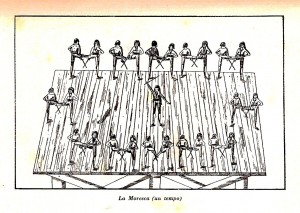Venice – Carnival old feasts – Moresca ,Hercules Strength .
At the time of the “Serenenissima Republic” Venice people was divided into two factions : Castellani and Nicolotti . The first , ( inhabitants of the area of San Nicolo dei Mendicoli , Santa Croce, San Polo and Dorsoduro ) with red cap and red scarf , representing the workers of the Arsenal , the second , ( people from the neighborhood of San Marco , part of Dorsoduro and Cannaregio, Lido , Castle districts) , with black scarf and black hat, most of them fishermen. The competition between the two venetian fractions, during the carnival , as in other ocasions, became a nornal thing .
The Strength of Hercules …the human pyramids , in which were challenged the performances by the two rival  factions of the Venetian districts the Castellani and Nicolotti .They exercised many years in dexterity, agility and balance .
factions of the Venetian districts the Castellani and Nicolotti .They exercised many years in dexterity, agility and balance .
Accompanied by music, they performed not only in San Marco square, but also in the Big Channel upon the rafts placed on the boats .An planking was placed on the barrels ( if the game was played on land ) or on two boats , (but was reaching the enabling of built pyramids on the basis of two gondola irons) ; on this unstable basis , the athletes had to form human pyramids who sometimes reached eight storey. At the base was formed by 10/12 men called “saorna”, ballast that support the second group with axles or by holding up the weight of the companions directly on their body, while on the top climbed a child called “cimiereto”. Arrived on, this was performing somersaults and back flips.
There were numerous variations allowed, so as to give variations to the original form, among the most famous are: “The Colossus of Rhodes”, “The Case of Mohammed,” “Bella Venezia”, “The Union”, “the Verginella “” Glory, “” Fame, “” the Lion “,” the Three bridges “,” The Caffaro “” the Duck, “” the Carega Imperial “,” el Gran Mogol “etc..
The Moorish dance (la moresca)
 The origins of that dance are uncertain: Some historians said that it has very ancient origins and is linked to farmers archaic rituals , such as propitiation of the good harvest represented by the fight against the malignant spirits .
The origins of that dance are uncertain: Some historians said that it has very ancient origins and is linked to farmers archaic rituals , such as propitiation of the good harvest represented by the fight against the malignant spirits .
During the carnival of Venice, after the Strength of Hercules , the Nicolotti and Castellani teams was exhibited the Moorish dance, a kind of collective fencing to the rhythm of the dance, ” fought ” with blunt swords called ” mele corte”. The performance started slowly in low musical rhythm and then sped up on the movements of the arms , ending in a kind of fury. It was an collective dance with pantomimic elements formed by two opposing armies, with swords, mimicking a fight at martial rhythm of one or more drums . One of the two groups of dancers blackening the face and all wore bells on their wrists and ankles to simulate the noise of the guns.
According to others, the origin of this dance would be tied to the Crusades as it would simulate the struggle between Christians and Moors . Finally, other scholars believe that it was introduced in Europe as a result of Spanish contamination and spread especially in the period between the fifteenth and the sixteenth century. These great feasts were held in the eighteenth century , when Carnival started on the first Sunday of October. On the last years this important event has lost much of the spirit of spontaneity that made it famous in the world. Nowadays the celebrations last about two weeks. In St. Mark’s Square and “in the camps” are organized pageants, concerts, shows and fireworks.
These great feasts were held in the eighteenth century , when Carnival started on the first Sunday of October. On the last years this important event has lost much of the spirit of spontaneity that made it famous in the world. Nowadays the celebrations last about two weeks. In St. Mark’s Square and “in the camps” are organized pageants, concerts, shows and fireworks.
CARNIVAL OF VENICE – official website http://www.carnevale.venezia.it/?slang=en
other items : http://dipoco.altervista.org/articles/
visit my website http://ginocosta.altervista.org/you-can-do-it.html